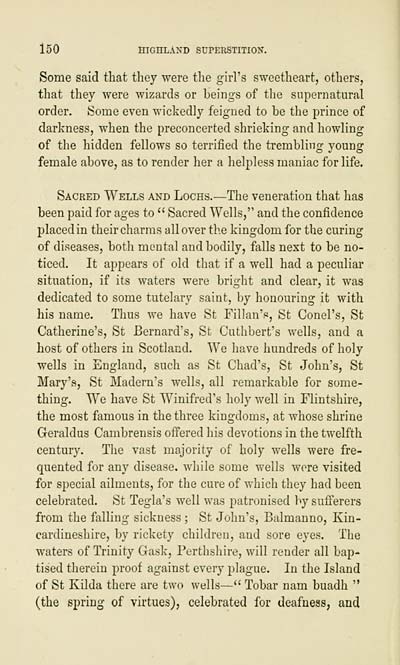Download files
Complete book:
Individual page:
Thumbnail gallery: Grid view | List view

150 HIGHLAND SUPERSTITION.
Some said that they were the girl's sweetheart, others,
that they were wizards or beings of the supernatural
order. Some even wickedly feigned to he the prince of
darkness, when the preconcerted shrieking and howling
of the hidden fellows so terrified the trembling young
female above, as to render her a helpless maniac for life.
Sacred Wells and Lochs. — The veneration that has
been paid for ages to " Sacred Wells," and the confidence
placed in their charms all over the kingdom for the curing
of diseases, both mental and bodily, falls next to be no-
ticed. It appears of old that if a well had a peculiar
situation, if its waters were bright and clear, it was
dedicated to some tutelary saint, by honouring it with
his name. Thus we have St Fillan's, St Conel's, St
Catherine's, St Bernard's, St Cuthbert's wells, and a
host of others in Scotland. We have hundreds of holy
wells in England, such as St Chad's, St John's, St
Mary's, St Madern's wells, all remarkable for some-
thing. We have St Winifred's holy well in Flintshire,
the most famous in the three kingdoms, at whose shrine
Geraldus Cambreusis offered his devotions in the twelfth
century. The vast majority of holy wells were fre-
quented for any disease, while some wells wore visited
for special ailments, for the cure of which they had been
celebrated. St Tegla's well was patronised by sufferers
from the falling sickness ; St John's, Balmanno, Kin-
cardineshire, by rickety children, and sore eyes. The
waters of Trinity Gask, Perthshire, will render all bap-
tised therein proof against every plague. In the Island
of St Kilda there are two wells — " Tobar nam buadh "
(the spring of virtues), celebrated for deafness, and
Some said that they were the girl's sweetheart, others,
that they were wizards or beings of the supernatural
order. Some even wickedly feigned to he the prince of
darkness, when the preconcerted shrieking and howling
of the hidden fellows so terrified the trembling young
female above, as to render her a helpless maniac for life.
Sacred Wells and Lochs. — The veneration that has
been paid for ages to " Sacred Wells," and the confidence
placed in their charms all over the kingdom for the curing
of diseases, both mental and bodily, falls next to be no-
ticed. It appears of old that if a well had a peculiar
situation, if its waters were bright and clear, it was
dedicated to some tutelary saint, by honouring it with
his name. Thus we have St Fillan's, St Conel's, St
Catherine's, St Bernard's, St Cuthbert's wells, and a
host of others in Scotland. We have hundreds of holy
wells in England, such as St Chad's, St John's, St
Mary's, St Madern's wells, all remarkable for some-
thing. We have St Winifred's holy well in Flintshire,
the most famous in the three kingdoms, at whose shrine
Geraldus Cambreusis offered his devotions in the twelfth
century. The vast majority of holy wells were fre-
quented for any disease, while some wells wore visited
for special ailments, for the cure of which they had been
celebrated. St Tegla's well was patronised by sufferers
from the falling sickness ; St John's, Balmanno, Kin-
cardineshire, by rickety children, and sore eyes. The
waters of Trinity Gask, Perthshire, will render all bap-
tised therein proof against every plague. In the Island
of St Kilda there are two wells — " Tobar nam buadh "
(the spring of virtues), celebrated for deafness, and
Set display mode to: Large image | Transcription
Images and transcriptions on this page, including medium image downloads, may be used under the Creative Commons Attribution 4.0 International Licence unless otherwise stated. ![]()
| Early Gaelic Book Collections > J. F. Campbell Collection > Prophecies of the Brahan seer (Coinneach Odhar Fiosaiche) > (162) |
|---|
| Permanent URL | https://digital.nls.uk/81547602 |
|---|
| Description | Volumes from a collection of 610 books rich in Highland folklore, Ossianic literature and other Celtic subjects. Many of the books annotated by John Francis Campbell of Islay, who assembled the collection. |
|---|
| Description | Selected items from five 'Special and Named Printed Collections'. Includes books in Gaelic and other Celtic languages, works about the Gaels, their languages, literature, culture and history. |
|---|

